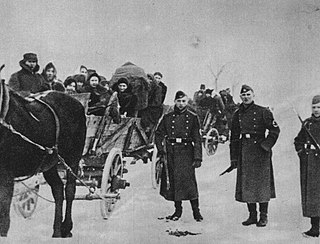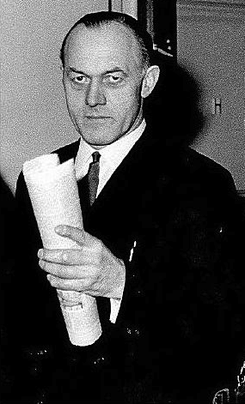
Nazi Germany used six extermination camps, also called death camps, or killing centers, in Central Europe during World War II to systematically murder over 2.7 million people – mostly Jews – in the Holocaust. The victims of death camps were primarily murdered by gassing, either in permanent installations constructed for this specific purpose, or by means of gas vans. The six extermination camps were Chełmno, Belzec, Sobibor, Treblinka, Majdanek and Auschwitz-Birkenau. Extermination through labour was also used at the Auschwitz and Majdanek death camps.

Treblinka was an extermination camp, built and operated by Nazi Germany in occupied Poland during World War II. It was in a forest north-east of Warsaw, 4 km (2.5 mi) south of the village of Treblinka in what is now the Masovian Voivodeship. The camp operated between 23 July 1942 and 19 October 1943 as part of Operation Reinhard, the deadliest phase of the Final Solution. During this time, it is estimated that between 700,000 and 900,000 Jews were murdered in its gas chambers, along with 2,000 Romani people. More Jews were murdered at Treblinka than at any other Nazi extermination camp apart from Auschwitz-Birkenau.

Belzec was a Nazi German extermination camp built by the SS for the purpose of implementing the secretive Operation Reinhard, the plan to murder all Polish Jews, a major part of the "Final Solution" which in total entailed the murder of about 6 million Jews in the Holocaust. The camp operated from 17 March 1942 to the end of June 1943. It was situated about 500 m (1,600 ft) south of the local railroad station of Bełżec, in the new Lublin District of the General Government territory of German-occupied Poland. The burning of exhumed corpses on five open-air grids and bone crushing continued until March 1943.

Operation Reinhard or Operation Reinhardt was the codename of the secret German plan in World War II to exterminate Polish Jews in the General Government district of German-occupied Poland. This deadliest phase of the Holocaust was marked by the introduction of extermination camps.

Odilo Lothar Ludwig Globocnik was an Austrian Nazi and a perpetrator of the Holocaust. He was an official of the Nazi Party and later a high-ranking leader of the SS. Globocnik had a leading role in Operation Reinhard, the organized murder of around one and a half million Jews, of mostly Polish origin, during the Holocaust in the Majdanek, Treblinka, Sobibor and Belzec extermination camps. Historian Michael Allen described him as "the vilest individual in the vilest organization ever known". Globocnik killed himself shortly after his capture and detention by British soldiers.

Josef Oberhauser was a low-ranking German SS commander during the Nazi era. He participated in Action T4 and Operation Reinhard. Oberhauser was the only person to be successfully convicted of crimes committed at the Belzec extermination camp. He was charged with 450,000 counts of accessory to murder and sentenced to 4.5 years imprisonment during the Belzec Trial of 1964.

Bełżec is a village in Tomaszów Lubelski County, Lublin Voivodeship, in eastern Poland. It is the seat of the gmina of Gmina Bełżec. It lies approximately 8 kilometres (5 mi) south of Tomaszów Lubelski and 114 km (71 mi) south-east of the regional capital Lublin. It is located in the Roztocze region.

Sonderaktion1005, also called Aktion1005 or Enterdungsaktion, was a top-secret Nazi operation conducted from June 1942 to late 1944. The goal of the project was to hide or destroy any evidence of the mass murder that had taken place under Operation Reinhard, the attempted extermination of all Jews in the General Government occupied zone of Poland. Groups of Sonderkommando prisoners, officially called Leichenkommandos, were forced to exhume mass graves and burn the bodies; inmates were often put in chains to prevent them from escaping.

Edward Frederick Langley Russell, 2nd Baron Russell of Liverpool CBE, MC, known as Langley Russell, was a British soldier, lawyer, historian and writer.

Lorenz Hackenholt was a member of the Schutzstaffel (SS) with the rank of Hauptscharführer. During World War II Hackenholt built and operated the gas chamber at the Bełżec extermination camp in occupied Poland during Operation Reinhard. In so doing, he personally carried out the murder of hundreds of thousands of people.

Richard Thomalla was a war criminal and SS commander of Nazi Germany. A civil engineer by profession, he was head of the SS Central Building Administration at Lublin reservation in occupied Poland. Thomalla was in charge of construction for the Operation Reinhard death camps Bełżec, Sobibor and Treblinka during the Holocaust in Poland.

The Oregon Holocaust Memorial is an outdoor memorial dedicated to victims of the Holocaust. Located in Portland, Oregon's Washington Park, the memorial was dedicated on August 29, 2004. Owned by the American Jewish Committee and constructed by Atlas Landscape Architecture and the Walsh Construction Company, the idea for a memorial was proposed in 1994 by Alice Kern and a local group of Holocaust survivors that met through the Oregon Holocaust Resource Center. According to Fodor's, the memorial is open daily from dawn to dusk and admission is free of charge.

Ernst Zierke was a low-ranking member in the SS who took part in the Action T4 forced euthanasia program in Nazi Germany, and after the invasion of Poland worked at Bełżec and Sobibór extermination camps during Operation Reinhard. Zierke helped to perpetrate the Holocaust. He was charged with being an accessory to the murder of 360,000 Jews at death camps, acquitted twice, in the Belzec and Sobibór trials of 1965 on grounds of acting under duress and set free.

The two Treblinka trials concerning the Treblinka extermination camp personnel began in 1964. Held at Düsseldorf in West Germany, they were the two judicial trials in a series of similar war crime trials held during the early 1960s, such as the Jerusalem Adolf Eichmann trial (1961) and the Frankfurt Auschwitz Trials (1963–65), as a result of which the general public came to realize the extent of the crimes that some two decades earlier had been perpetrated in occupied Poland by German bureaucrats and their willing executioners. In the subsequent years, separate trials dealt with personnel of the Bełżec (1963–65), Sobibor (1966), and Majdanek (1975–81) extermination camps.

The Sobibor trial was a 1965–66 judicial trial in the West German prosecution of SS officers who had worked at Sobibor extermination camp; it was held in Hagen. It was one of a series of similar war crime trials held during the early and mid-1960s, such as the 1961 trial of Adolf Eichmann by Israel in Jerusalem, and the Frankfurt Auschwitz Trials of 1963–65, also held in West Germany. These trials heightened general public and international understanding of the extent of the crimes that had been perpetrated in occupied Poland some twenty years earlier by Nazi bureaucrats and persons acting as their executioners.
Mark Irwin Forstater is an American film and TV producer, author, audio producer, music producer and tech entrepreneur, notable for producing the classic comedy film Monty Python and the Holy Grail and then in 2012 suing the five living members of Monty Python over a dispute regarding royalties from merchandising income, including the Spamalot musical, which was "lovingly ripped off from" the Holy Grail movie. He is a graduate of London Film School. He has resided in the United Kingdom since 1964.

There are two notable instances of lampshades made from human skin. After World War II it was reported that Nazis had made at least one lampshade from murdered concentration camp inmates: a human skin lampshade was reported to have been displayed by Buchenwald concentration camp commandant Karl-Otto Koch and his wife Ilse Koch, along with multiple other human skin artifacts. Despite myths to the contrary, there were no systematic efforts by the Nazis to make human skin lampshades.

Rudolf Reder a.k.a. Roman Robak was one of only two Holocaust survivors of the Bełżec extermination camp who testified about his experience after the war. He submitted a deposition to the Main Commission for the Investigation of German Crimes in January 1946 in Kraków. In terms of the number of Polish Jews who perished in its gas chambers, Bełżec had the third highest death toll among the six Nazi death camps located in occupied Poland, estimated between 500,000 and 600,000 men, women and children. Only Auschwitz-Birkenau and Treblinka had a higher victim count.

Martin Karl Hellinger was a German Nazi dentist who in 1943 was assigned to work at the concentration camp for women at Ravensbrück, with the duty of removing dental gold from those killed at the camp.


















